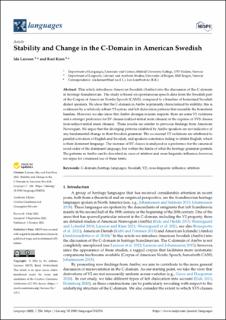Stability and Change in the C-Domain in American Swedish
Journal article, Peer reviewed
Published version

Åpne
Permanent lenke
https://hdl.handle.net/11250/3038732Utgivelsesdato
2022Metadata
Vis full innførselSamlinger
Sammendrag
This article introduces American Swedish (AmSw) into the discussion of the C-domain in heritage Scandinavian. The study is based on spontaneous speech data from the Swedish part of the Corpus of American Nordic Speech (CANS), compared to a baseline of homeland Swedish dialect speakers. We show that the C-domain in AmSw is primarily characterized by stability; this is evidenced by a relatively robust V2 syntax and left dislocation patterns that resemble the homeland baseline. However, we also show that AmSw diverges in some respects: there are some V2 violations and a stronger preference for SV clauses (subject-initial main clauses) at the expense of XVS clauses (non-subject-initial main clauses). These results are similar to previous findings from American Norwegian. We argue that the diverging patterns exhibited by AmSw speakers are not indicative of any fundamental change in their Swedish grammar. The occasional V2 violations are attributed to parallel activation of English and Swedish, and speakers sometimes failing to inhibit English, which is their dominant language. The increase of SV clauses is analyzed as a preference for the canonical word order of the dominant language, but within the limits of what the heritage grammar permits. The patterns in AmSw can be described as cases of attrition and cross-linguistic influence; however, we argue for a nuanced use of these terms.
